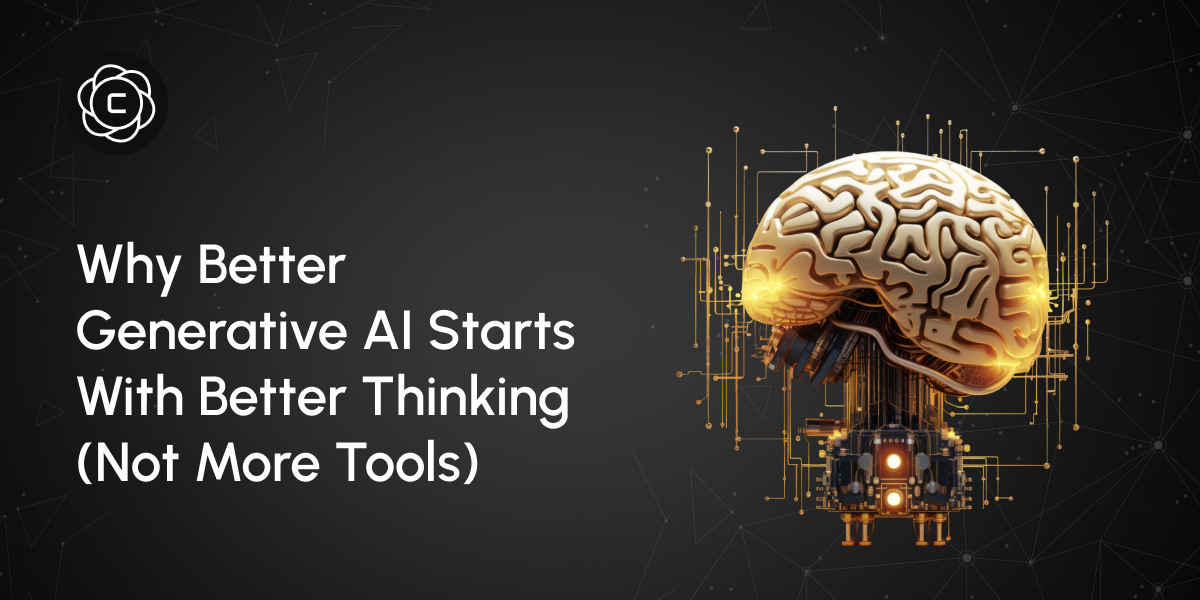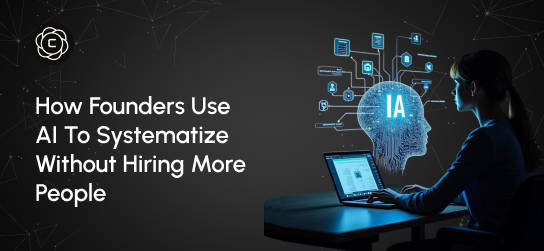LearningCenter
Master AI creativity with our comprehensive guides, tutorials, and expert insights. From beginner basics to advanced techniques.
Why Better Generative AI Starts With Better Thinking (Not More Tools)

Introduction
A few months ago, I sat down with a marketing director frustrated by her lack of results. She’d just spent $400 on AI subscriptions; ChatGPT, Claude, Jasper, a few more, but the output hadn’t improved. Same bland content. Same missed opportunities.
Her problem wasn’t a lack of technology. It was the absence of a structured approach.
This pattern is common. Professionals invest in more tools believing that volume equals value. But generative AI doesn’t create strategy. It amplifies it.
The most effective AI users I’ve worked with don’t rely on a stack of platforms. They rely on clear thinking and well-defined processes.
The Tool Collector's Trap
Many professionals begin their AI journey with the wrong question: What tool should I use? It sounds reasonable. But it’s the fastest way to lose momentum.
This mindset leads to what I call the tool collector’s trap: accumulating AI subscriptions in search of results that never arrive. One day you’re using Midjourney for visual content, the next you’re jumping between writing assistants, hoping something clicks.
What actually happens is fragmentation. Scattered workflows. Inconsistent tone. A content library filled with drafts that sound technically competent but strategically flat.
I’ve seen entire teams generate dozens of blog posts and email campaigns this way. None of it moves the needle, because the thinking behind it wasn’t anchored in real strategy.
If you want to see what AI is capable of, stop asking what tool to use. Start asking what thinking process you’re trying to improve. That's where real leverage begins.
What Separates AI Masters from Tool Collectors
After guiding hundreds of professionals through real-world AI integration, a clear pattern has emerged. The ones getting the most value don’t rely on having more tools, they rely on sharper thinking.
They Start with Clarity
Before prompting anything, they define the outcome with precision. It’s not “generate content,” but “craft an onboarding flow that converts trial users into paid accounts.” This clarity turns AI into a collaborator, not a content slot machine.
They Think in Systems
Rather than jumping between isolated tasks, they build workflows that compound. Each AI output informs the next step—strategy leads to messaging, messaging fuels campaigns, campaigns reinforce positioning. Everything connects.
They Question Everything
Top performers treat AI output as raw input. They ask: “What nuance is missing? Which stakeholder views aren’t represented? Does this resonate with the real-world dynamics of our audience?” This step transforms surface-level content into strategic assets.
These habits are tool-agnostic. They scale across platforms, evolve with the tech, and remain valuable no matter what AI looks like in five years. It's not about collecting tools. It's about sharpening how you think.
The Framework That Changes Everything
This is the thinking structure that fundamentally shifted how I work with AI. It’s simple to retain, yet reliably elevates the depth and precision of every session.
Context Before Commands
Most users jump in with direct instructions: “Write a blog post about productivity.” Experienced professionals begin with richer context: “I’m writing for mid-level marketers dealing with tool fatigue who need practical ways to simplify workflows.”
This step changes everything. AI can’t intuit what you want—but it can align with the scenario you describe.
Constraints Drive Creativity
It may seem counterintuitive, but clear limitations often spark better thinking. Instead of asking, “Brainstorm marketing campaigns,” try: “Create three campaigns under $500, aimed at small restaurant owners, executable in two weeks.”
Constraints sharpen focus for you and for AI.
Iteration Over Generation
The first output is rarely the final answer. Use it as a draft, not a destination. Ask for alternatives. Spot gaps. Rewrite with a clearer angle.
Writers know this. Designers know this. AI users need to adopt the same iterative posture.
Whether you're using Crompt’s AI Script Writer or another tool, this framework holds. The clarity of your prompt always mirrors the clarity of your thinking.
Real-World Application: A Case Study in Better Thinking
Let’s walk through how this framework works in practice. Just last week, a client came to me needing to rebuild their onboarding email sequence. Instead of jumping into tools, we started with how they think.
Traditional Approach (Tool-First Thinking):
"AI, generate an onboarding email sequence tailored for new customers."
Strategic Approach (Thinking-First Process):
Context Setting: "I’m designing for B2B software buyers who’ve just completed a free trial. They’re usually marketing leads at 20–50 person companies, familiar with the space, but unsure how complex our implementation is."
Constraint Definition: "Build a 5-email sequence. Each under 200 words. It should reduce implementation anxiety, offer one quick win within 48 hours, and lead users to book a demo call."
Iteration Strategy: "We’ll begin with raw email concepts. Then develop full drafts. Then adjust the tone and align it with brand and product."
The difference in output was immediate. Emails written with this thinking-first approach spoke directly to user concerns, moved the reader forward, and served real business goals.
Tools like Crompt’s Email Assistant didn’t need to fill in gaps, they just executed the strategy we’d already defined.
Why Clear Thinking Outperforms Any AI Tool
I’ve run this test hundreds of times: same model, same prompt, two users. The one with sharper thinking nearly always delivers stronger results.
That’s because generative AI doesn’t invent strategy, it amplifies it. It reflects your mental models, your clarity, your creative direction. Scattered input leads to scattered output. Strategic thinking makes AI powerful.
Take content creation. A vague request like “write about productivity” will return what you expect, generic advice already filling the internet.
But a strategic request reframes the interaction:
“My audience is made up of remote team leads struggling with asynchronous communication. They’ve tried every tool but still hit delays and frustration. I want to uncover the psychological blockers, not just recommend more apps.”
Same AI engine. Radically different output.
The Strategic Questions That Transform AI Interactions
Before every meaningful AI session, I walk through five simple questions. They changed how I work—and what I get from AI.
1. What specific outcome am I solving for?
Not just “content,” but “a landing page that converts trial users into paying customers.”
2. Who exactly is this for?
Demographics are helpful. But psychographics matter more. What do they believe, fear, and respond to?
3. What constraints apply?
Budget, timeline, delivery format, platform needs, tone.
4. What does success look like?
Define outcomes early. Are we measuring conversions? Engagement? Clarity?
5. How will I evaluate and evolve?
Iterate intentionally. Know how you’ll improve the output—not just generate it.
Whether you’re using Crompt’s Content Writer or another tool, these questions keep you in the driver’s seat. The tools follow where your thinking leads.
Building Your Personal AI Philosophy
The most effective AI users don’t just use tools—they operate from a defined philosophy. One that shapes how they frame challenges, direct the machine, and integrate output.
Here’s mine, refined over years of real-world application:
AI isn’t here to replace your thinking. It’s here to amplify it. I bring strategic clarity, emotional intelligence, and contextual judgment. AI brings acceleration, pattern recognition, and breadth of options.
I don’t expect the first output to be right. Every AI response is a draft—raw material to be shaped, challenged, and evolved.
And I never treat AI as mind reading. The clarity of your input shapes the usefulness of its output. Vague prompts yield vague ideas. Specificity unlocks insight.
Your philosophy will reflect your role, creative process, and domain demands. But you need one. Otherwise, you’re outsourcing your agency.
The Compound Effect of Better Thinking
When you prioritize thinking quality over tool variety, something important happens: your AI interactions become a source of leverage, not distraction.
You move from producing content to shaping assets. From isolated trials to repeatable systems. From over-reliance on tools to deep transferability across platforms.
And that change compounds. The stronger your thinking foundation, the faster you adapt to every new development in the AI ecosystem.
New models become interchangeable. What stays consistent is how you think, refine, and lead the interaction.
Your Next Step Forward
Pick one AI session from this week that felt disappointing. Now, zoom out and examine it:
What strategic context was missing?
What constraints could have sharpened the direction?
How might a second or third iteration have added depth?
Then try again—with a better thought process leading the way.
You’ll see it instantly. Better thinking transforms AI from a tool into a true partner.
That’s the shift. And it’s what Crompt is built to support, not just better tools, but better use of them through elevated thinking.
The future won’t belong to tool collectors. It’ll belong to those who can think with clarity and collaborate with intelligence.
Table of Content
- Introduction
- The Tool Collector's Trap
- What Separates AI Masters from Tool Collectors
- The Framework That Changes Everything
- Real-World Application: A Case Study in Better Thinking
- Why Clear Thinking Outperforms Any AI Tool
- The Strategic Questions That Transform AI Interactions
- Building Your Personal AI Philosophy
- The Compound Effect of Better Thinking
- Your Next Step Forward

Your Calendar Is Not Broken (Your Mental Operating System Is)
Last month, I watched a founder spend three hours reorganizing his calendar app for the fourth time this year. Different colors, new categories, smarter blocking strategies. By week two, he was back to the same chaotic pattern: overcommitted, constantly running late, and feeling like his day controlled him instead of the other way around. The problem wasn't his calendar. It was the mental operating system running underneath it. Calendar issues aren’t about tools; they’re about how you think about time. They download new apps, try productivity methods, and wonder why nothing sticks. Meanwhile, the real issue sits in how their brain processes time, priorities, and commitments.

How to Combine Human Thinking and Generative AI for Smarter Outcomes
Last Tuesday, I watched two product managers go head-to-head on the same challenge. Same tools. Same data. Same deadline. But the way they used AI couldn’t have been more different and the results made that difference unmistakable. One delivered a generic solution, familiar and easily replicated. The other crafted a proposal that felt thoughtful, grounded, and strategically distinct. Their CEO approved it for implementation within minutes. The gap wasn’t technical skill or AI proficiency. It was their thinking architecture, the way they framed the problem, used AI to explore, and layered in human context to guide the output.

Why Most AI Outputs Sound Generic (And How to Make Yours Stand Out)
Your AI-generated content sounds like everyone else's. The same corporate tone, predictable structure, and hollow phrases that readers recognize instantly as artificial. While AI promises creative efficiency, most outputs blend into the background noise of generic content flooding the internet. The problem isn't AI capability but user approach. Most people treat AI like a magic content machine: input basic prompts, receive polished output. This lazy approach produces lazy results that fail to engage readers or reflect authentic brand personality.
Stay Updated
Get the latest AI insights, tutorials, and feature updates delivered to your inbox.






